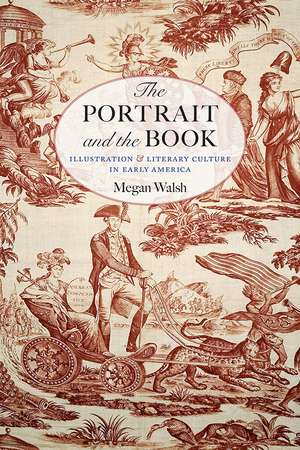The Portrait and the Book: Illustration and Literary Culture in Early America: Impressions
Autor Megan Walshen Limba Engleză Paperback – 14 mai 2017
In the nineteenth century, new image-making methods like steel engraving and lithography caused a surge in the publication of illustrated books in the United States. Yet even before the widespread use of these technologies, Americans had already established the illustrated book format as central to the nation’s literary culture. In The Portrait and the Book, Megan Walsh argues that colonial-era author portraits, such as Benjamin Franklin’s and Phillis Wheatley’s frontispieces; political portraits that circulated during the debates over the Constitution, such as those of the Founders by Charles Willson Peale; and portraits of beloved fictional characters in the 1790s, such as those of Samuel Richardson’s heroine Pamela, shaped readers’ conceptions of American literature.
Illustrations played a key role in American literary culture despite the fact there was little demand for books by American writers. Indeed, most of the illustrated books bought, sold, and shared by Americans were either imported British works or reprinted versions of those imported editions. As a result, in addition to embellishing books, illustrations provided readers with crucial information about the country’s status as a former colony.
Through an examination of readers’ portrait-collecting habits, writers’ employment of ekphrasis, printers’ efforts to secure American-made illustrations for periodicals, and engravers’ reproductions of British book illustrations, Walsh uncovers in late eighteenth-century America a dynamic but forgotten visual culture that was inextricably tied to the printing industry and to the early US literary imagination.
Illustrations played a key role in American literary culture despite the fact there was little demand for books by American writers. Indeed, most of the illustrated books bought, sold, and shared by Americans were either imported British works or reprinted versions of those imported editions. As a result, in addition to embellishing books, illustrations provided readers with crucial information about the country’s status as a former colony.
Through an examination of readers’ portrait-collecting habits, writers’ employment of ekphrasis, printers’ efforts to secure American-made illustrations for periodicals, and engravers’ reproductions of British book illustrations, Walsh uncovers in late eighteenth-century America a dynamic but forgotten visual culture that was inextricably tied to the printing industry and to the early US literary imagination.
Preț: 411.89 lei
Preț vechi: 484.58 lei
-15% Nou
Puncte Express: 618
Preț estimativ în valută:
78.82€ • 85.59$ • 66.21£
78.82€ • 85.59$ • 66.21£
Carte indisponibilă temporar
Doresc să fiu notificat când acest titlu va fi disponibil:
Se trimite...
Preluare comenzi: 021 569.72.76
Specificații
ISBN-13: 9781609385026
ISBN-10: 1609385020
Pagini: 278
Ilustrații: 25 illustrations
Dimensiuni: 152 x 229 x 20 mm
Greutate: 0.43 kg
Ediția:1
Editura: University of Iowa Press
Colecția University Of Iowa Press
Seria Impressions
ISBN-10: 1609385020
Pagini: 278
Ilustrații: 25 illustrations
Dimensiuni: 152 x 229 x 20 mm
Greutate: 0.43 kg
Ediția:1
Editura: University of Iowa Press
Colecția University Of Iowa Press
Seria Impressions
Notă biografică
MEGAN WALSH is associate professor of English at St. Bonaventure University. She lives in Olean, New York.
Descriere
In The Portrait and the Book, Megan Walsh argues that colonial-era author portraits, such as Benjamin Franklin’s and Phillis Wheatley’s frontispieces; political portraits that circulated during the debates over the Constitution, such as those of the Founders by Charles Willson Peale; and portraits of beloved fictional characters in the 1790s, such as those of Samuel Richardson’s heroine Pamela, shaped readers’ conceptions of American literature. Through an examination of readers’ portrait-collecting habits, writers’ employment of ekphrasis, printers’ efforts to secure American-made illustrations for periodicals, and engravers’ reproductions of British book illustrations, Walsh uncovers in late eighteenth-century America a dynamic but forgotten visual culture that was inextricably tied to the printing industry and to the early US literary imagination.




